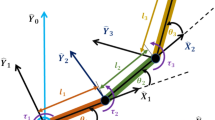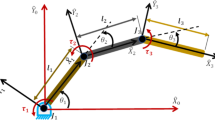Abstract
This study investigates a new fractional-order nonsingular terminal sliding mode control (FTSMC) leveraging a finite-time extended state observer, a simpler prescribed control, and hybrid grey wolf optimization (GWO) combined with whale optimization algorithm (WOA) for manipulator systems. The new FTSMC system is based on an improved fractional-order terminal sliding surface. Initially, the study experimentally optimizes the dynamic parameters and gains of the controller and the observer with the help of the newly developed GWO-WOA technique. As the next step, the uncertainties including optimization error and external disturbances are estimated by the finite-time extended state observer designed using the sliding mode dynamics. Experimental results of GWO-WOA optimization and joint position tracking for a self-designed articulated manipulator prove the efficacy of the proposed control scheme.
Similar content being viewed by others
References
X. Yan, K. Spurgeon, and C. Adward, “State and parameter estimation for nonlinear delay systems using sliding mode techniques,” IEEE Trans. Automatic Contr., vol. 58, no. 4, pp. 1023–2019, 2013.
S. Yu, X. Yu, B. Shrinzadeh, and Z. Man, “Continuous finite-time control for robotic manipulators with terminal sliding mode,” Automatica, vol. 41, pp. 1957–1964, 2005.
H. Hou, X. Li, L. Xu, K. A. Rsetam, Z. Cao, “Finite-time continuous terminal sliding mode control of servo motor systems,” IEEE Trans. Industrial Electr., vol. 67, no. 7, pp. 5647–5656, 2020.
L. Yang and J. Yang, “Nonsingular fast terminal slidingmode control for nonlinear dynamical systems,” International J. of Robust and Nonlinear Contr., vol. 21, pp. 1865–1879, 2011.
H. Wang, L. Shi, Z. Man, J. Zheng, and S. Li, “Continuous fast nonsingular terminal sliding mode control of automotive electronic throttle systems using finite-time exact observer,” IEEE Trans. Industrial Electr., vol. 65, no. 9, pp. 7160–7172, Sept. 2018.
M. P. Aghababa, “Design of a chatter-free terminal sliding mode controller for nonlinear fractional-order dynamical system,” Inter. J. of Control, vol. 86, no. 10, pp. 1744–1756, 2013.
H. R. Li, Z. B. Jiang, and N. Kang, “Sliding mode disturbance observer-based fractional second-order nonsingular terminal sliding mode control for PMSM position regulating system,” Mathematical Problems in Eng., vol. 2015, Arrticle ID 370904, 2015.
Y. Wang, L. Gu, Y. Xu, and X. Cao, “Practical tracking control of robot manipulator with continuous fractional-order nonsingular terminal sliding mode,” IEEE Trans. Industrial Electr., vol. 63, no. 10, pp. 6194–6204, Oct. 2016.
N. Ullah, M. A. Ali, A. Ideas, and J. Herrera, “Adaptive fractional order terminal sliding mode control of a doubly fed induction generator based wind energy system,” IEEE Access, vol. 27, pp. 21368–21381, 2017.
E. S. A. Shahri, A. Alfi, and J. A. T. Machado, “Stabilization of fractional-order systems subject to saturation element using fractional dynamic output feedback sliding mode control,” J. Computational and Nonlinear Dyn., vol. 12, no. 3, pp. 1274–1230, 2017.
W. Yaoyao, J. Surong, C. Bai, and W. Hongtao, “A new continuous fractional-order nonsingular terminal sliding mode control for cable-driven manipulator,” Advances in Engineering Software, vol. 119, pp. 21–29, 2018.
S. Haghighatnia, H. T. Shandiz, and A. Alfi, “Conformable fractional order sliding mode control for a class of fractional order chaotic systems,” International J. Industrial Electronics Control and Opt., vol. 2, no. 3, pp. 177–188, 2019.
J. A. Moreno and M. Osorio, “A Lyapunov approach to second-order sliding mode controller and observers,” Proc. of 47 th IEEE Confer. Decision and Contr., pp. 2856–2861, 2008.
R. Poli, J. Kenndy, and T. Blackwell, “Particle swarm optimization,” Swarm Intelligence, vol. 1, pp. 33–57, 2007.
M. Dorigo and C. Blum, “Ant colony optimization theory: A survey,” Theoretical Computer Science, vol. 344, pp. 243–278, 2005.
D. Karaboga and B. Akay, “A comparative study of artificial bee colony algorithm,” Applied Mathematics and Comp., vol. 214, no. 1, pp. 108–132, 2009.
O. Castillo and L. Amador-Angulo, “A generalized type-2 fuzzy logic approach for dynamic parameter adaptation in bee colony optimization applied to fuzzy controller design,” Information Science, vol. 460, pp. 476–496, 2018.
S. Mirjalili, S. M. Mirjalili, and A. Lewis, “Grey wolf optimizer,” Advances in Engineering Software, vol. 69, pp. 46–61, 2014.
L. Rodriguez, O. Castillo, M. Garcia, and J. Soria, “Constrained real-parameter optimization using the firefly algorithm and the grey wolf optimizer, hybrid Intelligent systems in control, pattern recognition, and medicine,” Studies in Computational Intelligence, vol. 827, pp. 155–167, Springer, 2019.
D. F. Sanchez, P. Melin, and O. Castillo, “A grey wolf optimizer for modular granular neural networks for human recognition,” Computational Intelligence and Neuroscience, vol. 2017, Article ID 4180510, 2017.
J. Oliveira, P. M. Oliveira, J. Boaventura-Cunha, and T. Pinho, “Chaos-based grey wolf optimizer for higher order sliding mode position control of a robotic manipulator,” Nonlinear Dynamics, vol. 90, no. 2, pp. 1353–1362, 2017.
O. O. Obadina, M. Thaha, K. Althoefer, and M. H. Shaheed, “A modified computed torque control approach for a master-slave robot manipulator system,” Annual Confer. Towards Automation Robotic Sys., pp. 28–39, 2018.
Z. Zhou, C. Wang, Z. Zhu, Y. Wang, and D. Yang, “Sliding mode control based on a hybrid grey-wolf-optimized extreme learning machine for robot manipulators,” Inter. J. for Light and Electron Optics, vol. 185, pp. 364–380, 2019.
H. Komijani, M. Masoumnezhad, M. M. Zanjireh, and M. Mir, “Robust hybrid fractional order proportional derivative sliding mode controller for robot manipulator based on extended grey wolf optimizer,” Robotica, vol. 38, no. 4, pp. 605–616, 2020.
S. Mirjalili, and A. Lewis, “The whale optimization algorithm,” Advances in Engineering Software, vol. 95, pp. 51–67, 2016.
J. H. Holland, “Genetic algorithm,” Scientific American, vol. 267, no. 1, pp. 66–73, 1992.
E. Rashedi, H. Nezamabadi, and S. Saryazdi, “GSA: A gravitational search algorithm,” Information Science, vol. 179, no. 13, pp. 2232–2249, 2009.
C. P. Benchlioulis and G. A. Rovithakis, “Robust adaptive control of feedback linearizable MIMO nonlinear systems with prescribed performance,” IEEE Trans. on Automatic Control, vol. 53, no. 9, pp. 2090–2098, Oct. 2008.
C. Hu, B. Yao, and Q. Wang, “Performance-oriented adaptive robust control of a class of nonlinear systems preceded by unknown deadzone with comparative experimental results,” IEEE/ASME Trans. Mechatronics, vol. 18, no. 1, Feb. 2013.
B. Bandyopadhyay and S. Kamal, Stabilization and Control of Fractional Order Systems: A Sliding Mode Approach, vol. 317, Springer, 2015.
Author information
Authors and Affiliations
Corresponding author
Additional information
Publisher’s Note Springer Nature remains neutral with regard to jurisdictional claims in published maps and institutional affiliations.
Recommended by Associate Editor Kang-Hyun Jo under the direction of Editor-in-Chief Keum-Shik Hong. This work was supported by the National Research Foundation of Korea(NRF) grant funded by the Korea government(MSIT) (No. NRF-2018R1A2B6005128) and was supported by the Dongguk University Research Fund of 2019.
Seong-Ik Han received his B.S. and M.S. degrees in mechanical engineering from Pusan National University, Busan, Korea, in 1987 and 1989, respectively, and a Ph. D. in mechanical design engineering from Pusan National University, Busan, in 1995. From 1995 to 2009, he was with Electrical Automation of Suncheon First College, Korea. From 2010 to 2017, he was with the Department of Electronic Engineering, Pusan National University, Korea. Now, he is with the Department of Mechanical System Engineering, Dongguk University Gyeongju Campus, Korea. His research interests include intelligent control, nonlinear control, robotic control, vehicle system control, and steel process control. He is the member of IEEE. He has published 70 papers in the international journals as the first or corresponding author.
Rights and permissions
About this article
Cite this article
Han, SI. Fractional-order Sliding Mode Constraint Control for Manipulator Systems Using Grey Wolf and Whale Optimization Algorithms. Int. J. Control Autom. Syst. 19, 676–686 (2021). https://doi.org/10.1007/s12555-020-0138-x
Received:
Revised:
Accepted:
Published:
Issue Date:
DOI: https://doi.org/10.1007/s12555-020-0138-x




